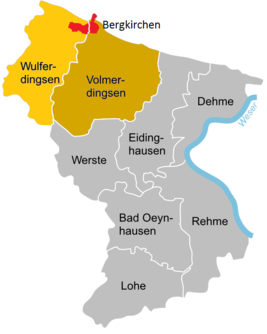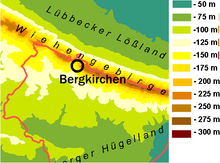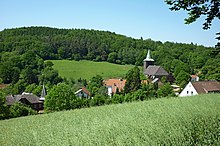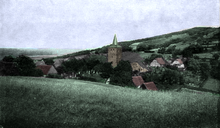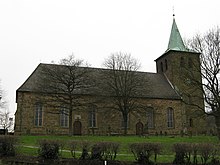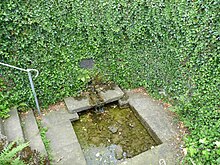Bergkirchen (Bad Oeynhausen)
|
Bergkirchen (Bad Oeynhausen)
City of Bad Oeynhausen
Coordinates: 52 ° 16 ′ 7 ″ N , 8 ° 46 ′ 28 ″ E
|
|
|---|---|
| Height : | 160 m above sea level NN |
| Residents : | 1500 (Dec. 31, 1961) |
| Incorporation : | 1st January 1973 |
| Postal code : | 32549 |
| Area code : | 05734 |
|
Location of Bergkirchen (Bad Oeynhausen) in Bad Oeynhausen
|
|
Bergkirchen is a church village within the East Westphalian town of Bad Oeynhausen in North Rhine-Westphalia . The village is the only one in the Minden-Lübbecke district , on the ridge of the Wiehengebirge at a pass crossing not far from the Bergkirchener Kopf . Administratively, Bergkirchen does not form a separate town or district, but belongs to the district of Wulferdingsen , a smaller part together with the eponymous church in Volmerdingsen . The Bergkirchen parish today comprises the districts of Bergkirchen and Wulferdingsen.
Geography and location
Bergkirchen is the northernmost part of the town of Bad Oeynhausen on the border with the Rothenuffeln district of the Hille community in the Minden-Lübbecke district . The border between the municipalities runs directly on the ridge of the Wiehengebirge except for a 100-meter-wide and 250-meter-long area stretching north , which fell to the city of Bad Oeynhausen with the territorial reform of 1973.
The residential area of Bergkirchen is predominantly at the foot of the Bergkirchener Kopf, but also with the town center occupies the pass height between this and the Rothenuffler Berg . Bergkirchen is the only village, especially with its church tower, that can be seen from afar from both sides of the mountain. Immediately south of the town center is the approximately 4.3 hectare nature reserve Knicksiek , and in the west the extensive nature reserve Wulferdingsener Mühlensiek stretches right to the edge of the village. The Wittekindsweg , which is part of the European long-distance hiking trail E11 , runs over the ridge of the Wiehengebirge and thus through the village center .
Since the village has not been an administrative unit for almost 200 years, no population is officially registered for it and no area of the district is reported.
climate
There are no long-term temperature measurements for Bergkirchen itself. The nearest weather measuring stations are each around 20 km south in Bad Salzuflen and northwest in Rahden-Varl. In Bad Salzuflen, at a similarly high altitude (135 m above sea level), the January average temperature is 1.8 degrees over the long term (period 1971-2000), the value for July is 17.7 degrees and the annual average 9.5 degrees Celsius. There is an average of 804 mm of precipitation.
history
Bergkirchen is believed to be over 1200 years old. Although the settlement was first mentioned in the 11th century, recent research suggests that as early as 799 on the occasion of the September trip of Pope Leo III. a wooden church was consecrated in Bergkirchen.
At the church, which is located on the aforementioned pass road, a commercial and trading center was built on the mountain. In the 19th century the market was relocated to Wulferdingsen.
Until 1843 Bergkirchen was the central place of the parish of the same name, to which, in addition to Bergkirchen, the localities and farmers Wulferdingsen, Haddenhausen with Biemke, Oberlübbe , Rothenuffeln and Unterlübbe with Hilferdingsen belonged, which lay on both sides of the Wiehen Mountains. As part of the introduction of the rural community order for the province of Westphalia , the district of Minden was divided into seven offices in December 1843. At the same time, all places that had their own household for their communal needs were given the status of a (rural) commune. The other places without parish status, including mountain churches, were assigned to larger parishes. Since then Bergkirchen belongs administratively to Wulferdingsen and Volmerdingsen.
In 1898 Bergkirchen was the center of public attention in the empire, even if only for a short time. The then German head of state, Kaiser Wilhelm II. , Moved with his general staff in the local medical center, later renamed Kaiser Apotheke, to an observation point as a “maneuver seat” for an imperial maneuver held in the area.
With the territorial reform in 1973 , the municipality of Wulferdingsen, including the mountain churches, was added to the city of Bad Oeynhausen. The Wiehengebirgsgemeinde demanded by Bergkircheners in the run-up to the territorial reform, which, with Bergkirchen as the central administrative center , should encompass the villages of the historic parish on both sides of the Wiehengebirge, could not be enforced.
Mountain pass
The road 772 runs over the Bergkirchener Wiegengebirgspass at 165 m above sea level. The pass road has on both sides with several serpentines partly the character of a mountain road , which is only found in the otherwise rather flat or slightly hilly region, at least in this form in a few other places in the district (e.g. Lutternsche Egge , Kahle Wart ). Heavy motorcycle traffic in summer on this route led to a discussion among residents.
Attractions
Church in Bergkirchen
A special attraction is the Protestant church Bergkirchen from 1756. The first church was probably built there 1200 years ago. The church is located in the area of the Volmerdingsen district.
Wittekindsquelle
To the southwest of the church tower is the Wittekindsquelle on the church grounds, presumed location of a medieval Saxon spring shrine and legendary location of the spring wonder, which tradition ascribes to the medieval Saxon Duke Widukind . According to legend, Widukind rode over the ridge of the Wiehengebirge and expected a sign from God whether he should change his faith, surrender to the militarily superior Charlemagne and thus end the Saxon Wars . As a result, his horse suddenly scratched a stone and spring water shot out. As a result of this sign, Widukind decided to convert to Christianity and submit to Charlemagne.
In the early 1970s, the spring dried up for reasons that could not be fully clarified. A water pump was installed by the working group for home care, which now lets water bubble again.
The amalgamation of a spring legend playing on a mountain pass with the decision to submit to the militarily superior Charlemagne, interpreted as a Christian-religious conversion experience, indicates that there was previously a Saxon spring shrine at the site of today's Bergkirchen church. At the church and at the Wittekinds spring below, information boards point to the legend and the presumed earlier spring sanctuary.
Bergkirchen watermill
The watermill Bergkirchen , also called Schöne Mühle , is one of the few so-called overshot watermills in the Minden-Lübbecke mill district. It has been owned by the Schöne / Haupt miller family for centuries; The current name of the mill is derived from this owner's name. Until the end of the 1970s it was still operated as such, combined with a land trade.
According to tradition, the mill is said to have been built “during the Thirty Years War ”, but there is no evidence. The mill building is made of broken stone and bricks. An overshot water wheel with a diameter of 3.8 m drives the mill device. At the beginning of the 1980s the mill was restored and placed under monument protection. Today the mill has a fully functional grinder and, as the only mill in the district, a restored oil mill, which was used in ancient times to press oil from rape, beech nuts or sunflower seeds .
The watermill is part of the Westphalian Mill Road and the Mill Route .
Natural monument
To the east of the parish hall and behind the rectory are two yew trees as a natural monument B.1.3. expelled. These clearly tower above the house and have a circumference of over three meters at the thickest point. In 1882 they survived the fire in the community center.
Memorial against war and violence
Opposite the church on the eastern slope of the Bergkirchener Kopf stands the memorial against war and violence. It was built in 1961 and goes back to an initiative of the Minden district association of returnees . The Eidinghauser sculptor Theodor Henke created it from red Obernbeck sandstone . Three steps made of this material lead over a small embankment to the memorial. On the first level there is the inscription "all dead", on the second level "killed by people" and on the third "1939–1945 and always". The steps lead the viewer to the actual memorial, a stone designed as a cross with the inscription “and love remains the foundation of the world despite blood and death and weapons” . A bronze plate is attached to the stone with a relief depicting prisoners behind barbed wire and the inscription "Do not forget us".
Memorial stone loan office
A bronze memorial plaque attached to a memorial stone that came to the Bergkirchen area as a boulder during the Saale Ice Age and is now located between the rectory and the former Konatorhaus has been a reminder of the establishment of the loan office in Bergkirchen . The memorial plaque bears the following inscription:
“In 1889 - the first savings and loan fund was founded in the former Bergkirchen parish. The teacher and cantor Heinrich Brinkmann officiated here from 1889 to 1924 as rendant. As a reminder in 1999. Heimatverein Bergkirchen e. V.
This southern Swedish granite boulder, weighing approx. 17 t, came to our area about 180,000 years ago. "
Boulder
Another granite boulder stands north of the church at the bus stop on the north side of the road. It bears the inscriptions on the west, south and east sides: "164.4 m above sea level", "Bergkirchen 2003" and "Heimatverein Bergkirchen".
Baron Carl Schlotheim grave and high cross memorial
The grave of Baron Carl Ludwig Theodor von Schlotheim and that of his wife Felicité-Melanie nee lies in the pass directly on the serpentine of Bergkirchener Straße and beyond the mountain ridge . Lagarde , daughter of the King of Westphalia , Jérôme Bonaparte . The grave is marked as a memorial on maps and is almost exactly on the border with the Hille municipality (the border, running along the road, touches the small meadow between the bend with the graves) at the northernmost point of Bergkirchen and the city of Bad Oeynhausen. The grave consists of a high cross memorial and a double grave with two cast iron crosses. On the 138th anniversary of Melanie von Schlotheim's death, who died impoverished in Rehme on July 8, 1876 , the grave was renovated in 2014 and now presents itself to the public in new splendor. A footpath on the way to the church leads past the grave. For motorized visitors, stopping on the busy road was dangerous for a long time. Therefore a parking lane and a seating area were created. The initiative of Freiherr von Schlotheim, from 1849 to 1869 district administrator of the then Minden district , is u. a. thanks to the mountain pass road. The road that leads from Hartum via Rothenuffeln and Bergkirchen to Eidinghausen was opened to the public in 1857 as the first completed construction section. At the same time, the district administrator was given a monument, the high-cross memorial made of sandstone. The memorial stone was erected in the neo-Gothic style. On the north side of the monument the coat of arms of those of Schlotheim is depicted and the sentence "Erected on September 24, 1857" can be seen. Schlotheim's wish to be buried with his wife at this point was later granted.
Organizations / associations
Evangelical parish
The Bergkirchen parish includes the places Wulferdingsen and Bergkirchen, but including the Bergkirchen areas that are administratively part of Volmerdingsen. Most of the residents of Wulferdingsen (including Bergkirchen) belong to the Evangelical Lutheran Parish Bergkirchen. The YMCA Bergkirchen is organized as part of the church community . a. Has been involved in an amateur theater group for several years.
The parish maintains a parish hall in both Bergkirchen and Wulferdingsen .
The community has partnerships with Mwangoi in Tanzania and Ribnita in Moldova .
Heimatverein Bergkirchen
The Bergkirchen Heimatverein has been taking care of the district's concerns for decades.
Web links
Individual evidence
- ↑ City map with drawn district boundaries
- ↑ Law on the reorganization of the municipalities and districts of the reorganization area Bielefeld (Bielefeld Law) of October 24, 1972, § 17 (2)
- ↑ Bad Salzuflen climate diagram
- ^ Page of the website of the Rotheuffeln Heimatverein
- ↑ Website of the Kaiserapotheke Bergkirchen ( Memento of the original from December 14, 2015 in the Internet Archive ) Info: The archive link was automatically inserted and not yet checked. Please check the original and archive link according to the instructions and then remove this notice.
- ↑ A film recording of a car drive over the pass and through Bergkirchen from the south, first on the Volmerdingsener Strasse, then to the north on the Bergkirchener Strasse on YouTube
- ↑ Bergkirchen racetrack - residents feel abandoned by the authorities, article in the Mindener Tageblatt from October 17, 2015
- ↑ A Brief History of Bergkirchen, Chapter 9
- ^ Heinrich Müller and Ulrich Müller Kolck: A small story of the mountain church . Berlin 2008, p. 61 f.
- ↑ Page about the Bergkirchen mill
- ↑ Regulatory authority ordinance of the Minden-Lübbecke district
- ↑ The old, green giants, article in the NW
- ↑ A Brief History of Bergkirchen, Chapter 8
- ↑ Article about the grave in the Neue Westfälische
- ^ Article in the Neue Westfälische on March 10, 2015
